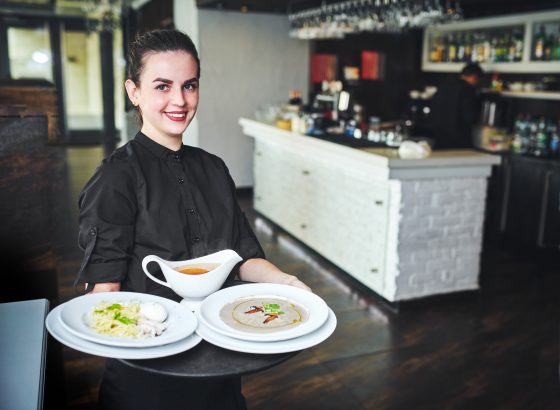Slips, trips, and falls are preventable in restaurants when employers work with front-line workers to address hazards.

gettyimages.ca/6okean
A friend of mine was working in the kitchen at a popular nightclub. He says: “I was taking a hotel tray of chicken wings out for a buffet we were putting on. I lost my footing because of the slick tiled floor and dumped the entire tray all over myself.”
He wasn’t hurt, but he felt shaken up, especially when his employer expressed anger about the loss of the food. Another time, he slipped at work while bussing tables, wearing a formal, white uniform in a fancy restaurant. He says, “I had just cleared a table of all their plates when my heel came in contact with a tomato top, and I went sliding into the dish pit. Plates smashed everywhere.”
Then his employer reprimanded him for breaking the plates.
Another friend told me a similar story. “Years ago when I was a server, another server was bringing a tray of clean glassware up to the bar and slipped,” she says. “The glassware smashed to pieces and was everywhere. But it was hard for her to get up without assistance because she couldn’t really put her hands down on the floor to hoist herself up.”
My friend helped her fallen co-worker get up and out of the broken glass. Thankfully, she wasn’t hurt, but many others are. One-quarter of workplace injuries in B.C.’s restaurants, bars, and pubs are from slips, trips, and falls, costing the industry $20 million in claims costs in the last five years.
Employers reminded of responsibility to identify and fix hazards
See WorkSafeBC’s reminder to employers and workers about the dangers from slips, trips, and falls in the food and beverage services industry. Employers – along with owners, managers, and supervisors — are reminded of their crucial role in identifying hazards and preventing these all-too-common incidents. This includes talking with front-line workers who have had experiences like the ones described above to get their ideas about how a future incident can be prevented. (And don’t blame the worker for loss of food or glassware!)
Managing risk includes:
- Identifying the hazards: Inspect the workplace, create a slip and trip map, and review feedback and reports. Be sure to talk to workers, supervisors, and joint health and safety committee members, as they are the ones most aware of the hazards they face every day.
- Assessing the risks: Rank hazards by probability and severity, and prioritize the most common and severe ones.
- Implementing effective controls: The most effective control is to eliminate hazards at the source (e.g., remove the slip or trip hazard). If that’s not possible, look at substitution (e.g., relocate walkways or change floor-cleaning methods) or engineering controls (e.g., slip-resistant mats, installing handrails).
Contrary to what people expect — that workers will fall from a ladder or from a ledge — most falls in this industry are actually happening in situations where workers are walking on a flat area or on stairs.
Check out WorkSafeBC’s Preventing Slips, Trips, and Falls in the Workplace for practical advice on effectively managing risks by identifying the hazards and implementing controls.
Thank you to everyone who shared their stories. Anyone else? Do let me know in the comments below.


